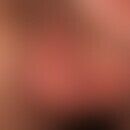DefinitionThis section has been translated automatically.
EtiopathogenesisThis section has been translated automatically.
Different triggers are possible:
- Hereditary enzyme defect: Acrodermatitis enteropathica.
- Zinc loss in diarrhea, fistula secretion (e.g. ulcerative colitis).
- Malabsorption (e.g. enteritis regionalis, celiac disease, Wilson's disease, pancreatitis)
- Burns
- Malnutrition (e.g. alcoholism, vegetarian diet)
- Increased consumption/excretion (e.g. growth, pregnancy, breastfeeding, atopic eczema, diabetes mellitus, liver cirrhosis, infections, diuretics)
You might also be interested in
LocalizationThis section has been translated automatically.
ClinicThis section has been translated automatically.
Acute: episodic papulovesicular, sharply defined eczema. Perioral and perianal erosions, scrotal eczema. Flat blisters in the flexural folds of the fingers and palmae. Delayed wound healing.
Chronic zinc deficiency dermatitis: Eczematous to psoriasiform skin changes, possibly generalized exsiccation eczema, acneiform folliculitis, diffuse alopecia, nail dystrophy, Beau-Reil's transverse furrows of the nails. Other disorders: growth retardation, susceptibility to infections, gastrointestinal disorders, photophobia, mental disorders. See also Acrodermatitis enteropathica.
DiagnosisThis section has been translated automatically.
Differential diagnosisThis section has been translated automatically.
TherapyThis section has been translated automatically.
- Alimentary intake: 33% of the zinc sources in the diet come from meat and meat products, 25% from milk, dairy products and eggs, 20% from cereal products and 20% from other sources.
Remember! A high calcium content and a low-fat diet worsen the zinc utilization.
- Drug substitution: Mostly oral, in severe cases parenteral administration of soluble zinc compounds such as zinc sulphate, zinc acetate, zinc lactate under serum zinc level control. Substitution e.g. with unicinc 20-40 mg/day i.v. or 1-2 Tbl./day p.o. In addition protein substitution (zinc is transported in serum bound to albumin). Serum protein control: Desired plasma protein increase (g/l) times plasma volume (l/kg bw) times 2 = amount of protein substitution required (albumin 5-20%).
LiteratureThis section has been translated automatically.
- Brar BK et al (2003) Acrodermatitis enteropathica-like rash in an exclusively breast fed infant with zinc deficiency. J Dermatol 30: 259-260
- Brüske K et al (1987) Zinc and its importance in some dermatological diseases-a statistical analysis. Z Hautkr 62: 125-131
- Crone J et al (2002) Acrodermatitis enteropathica-like eruption as the presenting sign of cystic fibrosis--case report and review of the literature. Eur J Pediatr 161: 475-478
- Landthaler M et al (1987) Acquired zinc deficiency syndrome. Dermatologist 33: 49-52
- Maverakis et al.(2007). Acrodermatitis enteropathica and an overview of zinc metabolism. J Am Acad Dermatol 56: 116-124
- Perafan-Riveros C et al (2002) Acrodermatitis enteropathica: case report and review of the literature. Pediatric Dermatol 19: 426-431
- Steel M (1988) Zinc deficiency, often not detected - zinc substitution, the therapy of choice. Therapeutic ion 2: 21-27
- Weismann K et al (1982) Zinc deficiency dermatoses. Dermatologist 33: 405-410
Incoming links (8)
Acrodermatitis enteropathica; Gluten-Related Dermatological Disorders; Intestinal diseases, skin changes; Necrolytic acral erythema; Sebostasis; Trace elements, deficiency symptoms; Zinc; Zinc sulphate;Outgoing links (17)
Acrodermatitis enteropathica; Alopecia (overview); Asteatotic dermatitis; Atopic dermatitis (overview); Beau-reilsche cross furrows of the nails; Bubble; Crohn disease, skin alterations; Eczema (overview); Folliculitis (overview); Gluten-Related Dermatological Disorders; ... Show allDisclaimer
Please ask your physician for a reliable diagnosis. This website is only meant as a reference.




